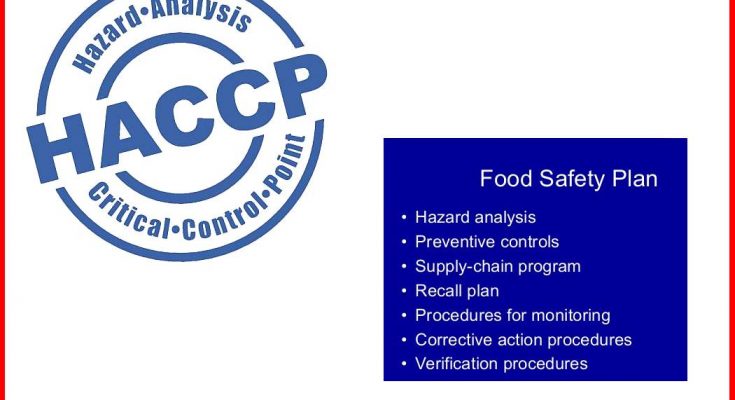Food safety as control is exceptionally mind-boggling. It can turn out to be particularly convoluted for makers as they battle to address developing guidelines, regulations and moving the industry to fundamental factors. Amidst this disarray and the wake of the FSMA rollout, numerous food safety/handling-related terms are thrown around. Shockingly, not every one of them is perceived or effectively addressed by individuals utilizing them. Today we will take apart two of these specific ideas of food safety and HACCP plan for meat processing and clarify precisely what makes them unique.
What is HACCP?
Every element along the food chains shares duty regarding food safety/handling and quality. This obligation includes setting up and keeping up proactive and powerful food safety/handling the management frameworks at the assembling or manufacturing level.

The Hazard Analysis Critical Control Points (HACCP) framework depends on controlling/handling primary focuses in food to forestall sanitation/hygiene issues. This framework was considered during the 1960s by the Pillsbury Corporation and the U.S. Public Aeronautics and Space Administration (NASA).
It started as an apparatus to ensure the security of nourishment for space travelers in the primary space missions. It was subsequently consolidated into the Codex Alimentations of the World Health Organization (WHO). HACCP has been generally acknowledged by government offices, exchange affiliations, and the food business internationally as the framework for controlling and examining safe food creation rehearses.
There are seven rules that makeup HACCP:
- Build up essential cutoff points
- Build up checking techniques
- Recognize basic control focuses
- Build up remedial activities
- Build up confirmation and verification techniques
- Lead a peril examination
- Build up record-keeping strategies
These standards can be applied to all elements of the food and drink industry, including:
- Developing
- Reaping/harvesting
- Handling/processing
- Assembling/manufacturing
- distributing
- Marketing
- Getting ready for utilization
Carrying out HACCP plans viably in food preparing plants, retail food stores, and foodservice activities includes building an organization of essential projects like current Good Manufacturing Practices (cGMPs), just as executing the accompanying primer advances:
- Assembling/Amassing a HACCP group
- Depicting the food and its dispersion
- Depicting the proposed use and shoppers of the food
- Building up a stream graph showing the interaction
- Confirming the stream graph
HACCP frameworks have been mandated/commanded by U.S. Government guidelines given by the Food and Drug Administration (FDA) for fish and squeeze and by the Food Safety and Inspection Service (FSIS) for meat and poultry. A few associations require a different HACCP plan for every food item, preparing technique, and office for which great dangers are implied.
What is a Food Safety Plan?
As you can see from the past segment, HACCP has not been ordered for all nutritional categories, especially the HACCP plan for meat processing. However, with the new rollout of the Food Safety Modernization Act (FSMA), any food handling substance that was not already dependent upon HACCP is presently needed to create and carry out a Food Safety Plan (FSP).
The FDA characterizes a Food Safety Plan (FSP) as “the essential reports in a preventive controls food safety/hygiene, sanitation framework that gives a deliberate way to deal with the recognizable proof of food handling perils that should be controlled to forestall or limit the probability of foodborne sickness or injury. It contains an assortment of composing reports that portray exercises that guarantee food security during assembling, handling, pressing, and holding.”
These reports include:
- Danger/hazard examination to distinguish whether risks are requiring a preventive control
- Preventive controls, as fitting to the office and the food, to guarantee safe food is created (e.g., controls for a measure, food allergens, disinfection, inventory network, and review plan)
- Techniques for checking the execution of preventive controls, as proper to the idea of every preventive control and its part in the office’s food handling framework
- Remedial activity systems, as suitable to the idea of each risk and preventive control
- Confirmation methodology, as suitable to the idea of every preventive control and its part in the office’s food handling framework
Compliant with this written setup, the FDA orders the accompanying necessities:
- You should keep up records reporting that the FSP is being executed.
- The FSP should be created or managed by preventive control qualified individual (PCQI), an individual with specific schooling, preparing, or experience to develop and apply a food handling framework.
- It should be marked and dated by the proprietor, administrator, or specialist accountable for the office when it is first finished and at whatever point it is adjusted.
- The FSP overall should be reanalyzed something like clockwork.
- There is no normalized design for an FSP. You can utilize whatever structure turns out best for your office, given that it incorporates the entirety of the necessary data.
Difference between HACCP plans and FSPs?
Various pieces of evidence differentiate HACCP plans from Food Safety Plans, including the accompanying subtleties portrayed by the FDA:
Danger or hazard Analysis
For the motivations behind HACCP, this alludes to natural, substance, and actual perils.
With regards to an FSP, this additionally incorporates radiological dangers and risks because of monetarily persuaded defilement.
Preventive Controls
For the motivations behind HACCP, these apply to deal with related primary control focuses (CCPs).
With regards to an FSP, they can apply to controls at different focuses that are not CCPs.
Measures and Values
For the motivations behind HACCP, there should be essential cutoff points at CCPs.
Regarding an FSP, there are characterized boundaries/limits with the most minor and most remarkable qualities, yet they may not be functional or required for non-measure-related preventive controls.
Observing
For the reasons for HACCP, checking is constantly needed for CCPs.
Regarding an FSP, observing is required uniquely as fitting for preventive controls, and it may not be necessary for some preventive controls that are not applied at CCPs.
Restorative Actions and Corrections
For HACCP, remedial activities are required when there are deviations from a CCP’s primary cutoff.
Regarding an FSP, prompt rectifications might be more suitable than a particular remedial activity (implying item hazard assessments of item wellbeing) for some preventive controls.
Check and Verification Process
For the reasons for HACCP, check exercises are needed for measure controls.
Regarding an FSP, there is adaptability to direct check exercises as fitting to the food, the office, and the idea of the preventive control.
Approval
Some HACCP frameworks (e.g., for juice, meat, and poultry items), especially the HACCP plan for meat processing, require approval of the arrangement in general.
With regards to an FSP, approval implies getting and assessing logical and specialized proof that a control measure, mix of measures, or the FSP, all in all, is prepared to do viably controlling the distinguished dangers. The degree of approval exercises might be less thorough for some preventive controls than others or may not be needed (e.g., sterilization controls).
Records
For the reasons for HACCP, records are needed for measure controls.
With regards to an FSP, records are needed as suitable for every single preventive control.
Review Plan
For the motivations behind HACCP, a review plan isn’t needed.
Regarding an FSP, a review plan should be ready for every item for which a risk requiring preventive control has been distinguished.
It is essential to note that much of the time, HACCP plans are a fundamental part of the generally FSP. So, while these two ideas are not compatible, they are unquestionably interrelated.
Since you have a more transparent comprehension of these two fundamental sanitation components, make a move to guarantee that you are dealing with your arrangements as per your industry’s consistent guidelines and food handling norms. The best method to robotize, arrange and control these endeavors is by receiving savvy food handling programming with the abilities to:
- Limit idle sitting time (sat around) and assets that outcome from lazy, manual documentation endeavors and human mistake
- Keep up report control and security, as smooth out the interaction of reliably refreshing your arrangements
- Shading code test focuses on your plant floor plan to evaluate the condition of your plant with one look, just as improve correspondence and consistency all through your association
- Effectively create plans that help your organization’s trying plans, including hearty randomization that guarantees great inclusion
- Total the entirety of your testing information in one spot, just as channel and print answers for any review in minutes
- Set up work processes and naturally advise partners as indicated by your inside approaches, with each progression being recorded and time-stepped as a stimulating activity advances toward fulfillment
- Get a moment to preview the wellbeing and execution of your locales utilizing excellent perception and detailing dashboards
- Earn visibility, acknowledged into patterns and areas of interest across the entirety of your plants to illuminate how to upgrade your food handling program
Read More: Are you prepared to work with food wholesale distributors?



